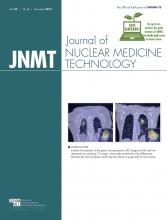Norman E. Bolus, MSPH, MPH, CNMT, FSNMMI-TS
In light of recent events in September and October 2014, there is concern about several viruses: Ebola (a hemorrhagic fever virus borne by blood, bodily fluids, and droplets), Enterovirus D68 (a nonpolio respiratory enterovirus spread by droplets from saliva, nasal mucus, and sputum, affecting mainly children with asthma), and the lesser known Chikungunya (a blood-borne virus spread by mosquitoes in the southern United States). All begin with flulike symptoms and currently have no available vaccines. The Ebola virus can have a high fatality rate—about 50% in the current outbreak. Enterovirus D68 complicates treatment in children with asthma, and some have died from the disease even with extensive advanced airway therapy. Chikungunya has a high rate of infection, with some 90% of those bitten by a disease-carrying mosquito becoming infected, but it is rarely fatal. Perhaps because these viruses are in the public eye, you have recently reviewed your standard precautions for infectious diseases.
I took time to demonstrate for my students standard precautions and persomal protective equipment (PPE), and immediately I became aware of a few shortcomings. First, the isolation gown that we use for patients with tuberculosis or other contact-isolation diseases would be totally ineffective for someone who is projectile-vomiting blood or oozing blood from orifices, as happens in end-stage hemorrhagic fever diseases such as Ebola. Second, although putting on double gloves, double booties, an N95 mask, a face shield, and an isolation gown is easy, it is difficult to remove these without contaminating oneself or the surrounding areas such as tabletops and chairs. Third, the full attire, as basic as it is, is hot and bulky when worn over a lab coat. In fact, in full protective gear, one can work effectively for perhaps only 30 minutes before having to take a break, which would require taking off all the gear and then putting on new gear. This situation would be worse in environments with no air conditioning. Although what I demonstrated to my students was the very least one would do to draw blood from someone infected with Ebola, I realized how hard this would be for someone who has no prior experience in putting on and taking off even the basic isolation PPE. Soon after my demonstration to my students, the Centers for Disease Control and Prevention (CDC) came out with new standards for dealing with Ebola that include a full protective PPE including head-to-toe covering with fluid-proof or fluid-resistant gowns and a partner to assist with putting on and taking off the PPE. CNN Medical Correspondent Dr. Sanjay Gupta demonstrated on television how difficult it was—with the original CDC recommendations—for him to remove his PPE when melted chocolate was splattered on him. This demonstration may have contributed to the new recommendations from the CDC.
NMTs should already be familiar with techniques such as these, because standard PPE is commonly used as a precaution in dealing with patients and in cleaning radioactive spills. I think the difference between Ebola patients and radioactive spills is that spills generally are not an active process once cleanup begins, as opposed to projectile vomiting or severe bloody diarrhea. We also have the advantage of being able to check for removable contamination once we have cleaned an area after a radioactive spill, and we can check ourselves with a Geiger counter to determine whether we became contaminated with radionuclides when we are removing our PPE. Apparently, unlike radioactive spills, the Ebola virus can spread to health-care workers even if they are following all suggestions by the authorities. Therefore, the primary way to prevent spread of disease in the hospital (and to prevent infections and contamination) remains effective hand washing or use of a hand sanitizer with at least 60% alcohol before and after contact with any patient and before and after donning and removing PPE. Perhaps with the Ebola virus a good shower afterward would not be a bad idea either.“The Greek Mythological Story of ‘Pandora’s Box’ teaches us the significance of self-control and self-discipline that can keep us away from the evils in the world. It also assures us that at the end of the day, there is always Hope—despite the severe storms of challenges, and when everything seems so dark and bleak. Never lose Hope, especially while overcoming the challenges of life.”
—Deodatta V. Shenai-Khatkhate (U.S. scientist and inventor)
In this edition of JNMT, there are 5 teaching case studies on a range of topics including PET/CT, PET, bone scanning, 123I whole-body scanning, and white blood cell osteomyelitis. There is an original CE article on the medical isotope production crisis, a procedure standard CE offering on gastrointestinal bleeding scintigraphy, and a reprinted CE article from JNM on hepatobiliary imaging in 2014. As a reminder, if you received credit for this article when it was originally published, you cannot receive credit twice. There are also general imaging articles, articles on practice management and radiopharmacy, updates from 3 international nuclear medicine organizations, a perspective from Canada evaluating available techniques for labeling red blood cells with 99mTc, and other interesting reports.
Our online discussion for this edition is simply, “What are your concerns about the Ebola virus outbreak in the United States, and what has your hospital or clinic done to prepare you for it?” Please go to www.snm.org/facebook and add your comments.








